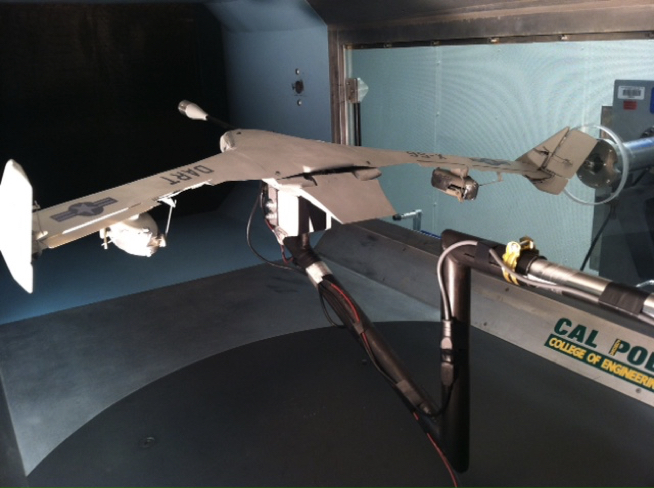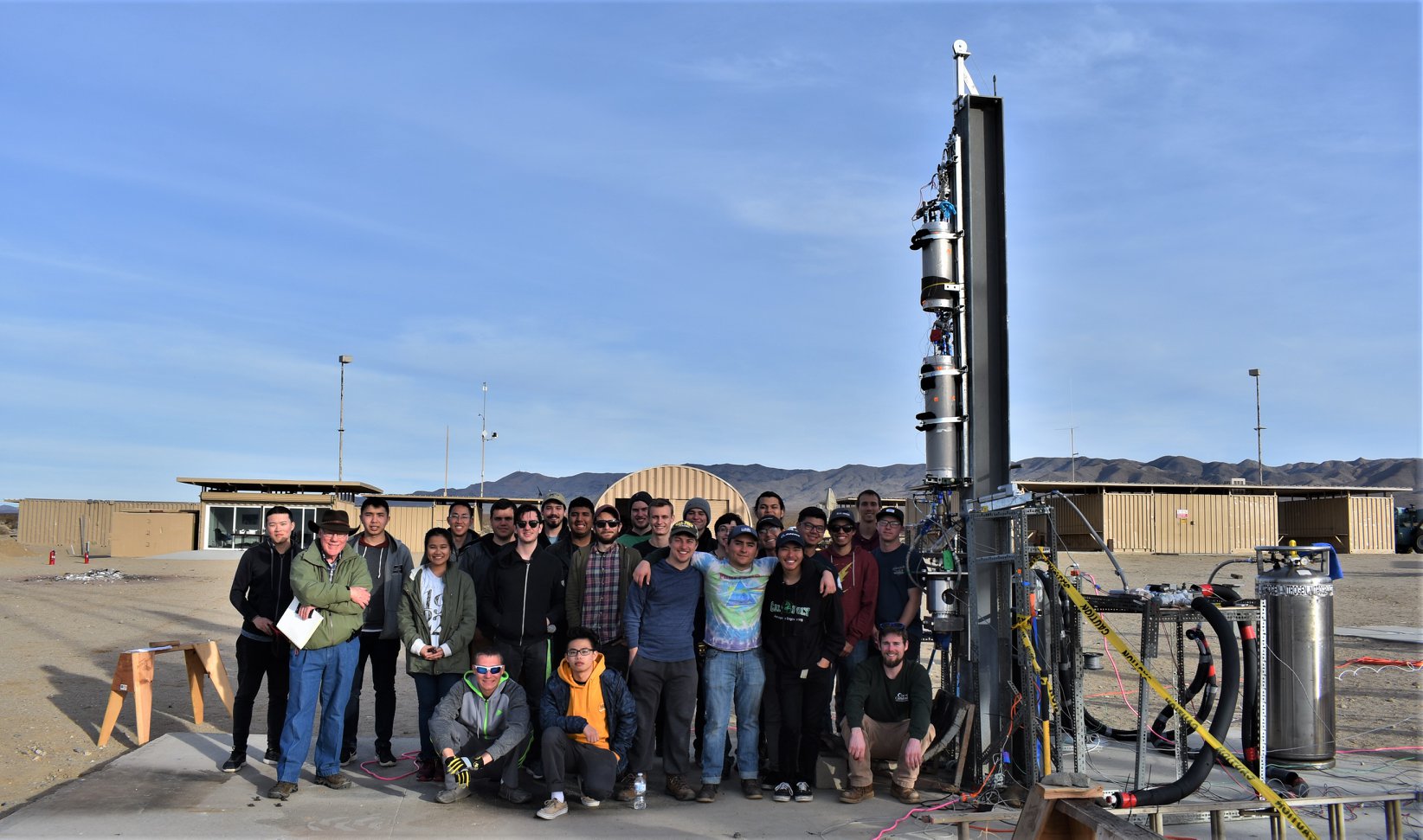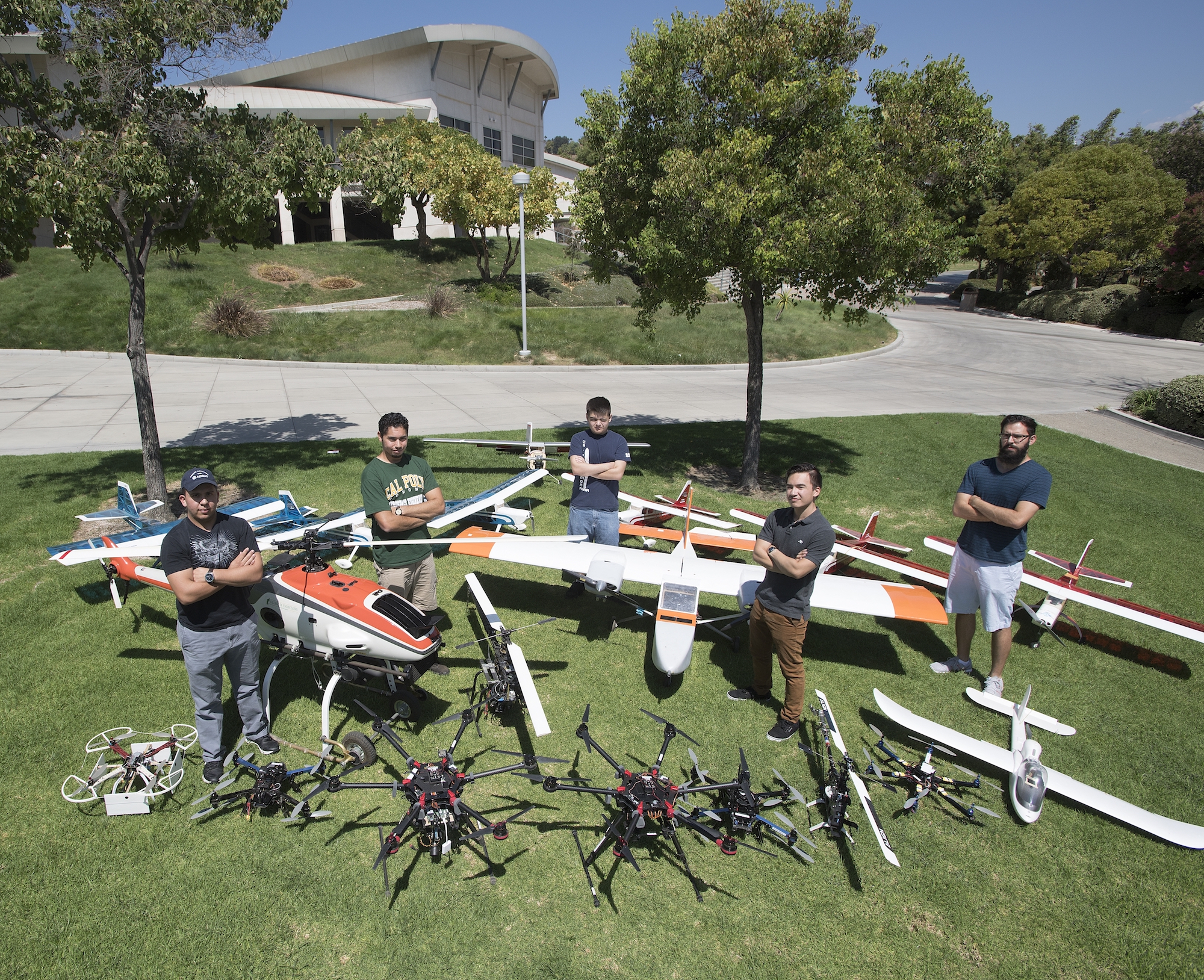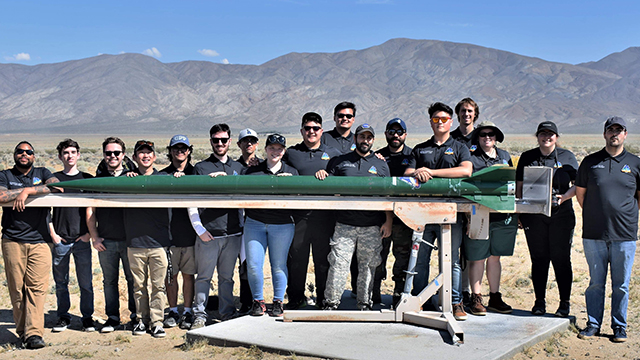Laboratories
Aerospace Laboratories
The Aerospace Engineering Department dedicates ten laboratories to the students and faculty. The labs are used in the curriculum as part of the hands-on teaching approach as well as for research and projects by students and faculty.
Subsonic Wind Tunnel
Directors: Dr. Ali Ahmadi & Prof. Steve Dobbs
 Cal Poly Pomona's Subsonic Wind Tunnel is a continuous flow tunnel with a test section size of 40" x 28" x 78" and speeds up to 200 mph. The tunnel is equipped with a sting-type, six-component force balance, and model support and positioning system that can set angles of attack up to 35 degrees and angles of yaw up to 20 degrees. The tunnel is also equipped with a side wall mount, a 5-component force balance, and a model positioning system, which sets the angle of attack of the model. This mounting system enables the testing of semi-span aerodynamic models at the double the test Reynolds number.
Cal Poly Pomona's Subsonic Wind Tunnel is a continuous flow tunnel with a test section size of 40" x 28" x 78" and speeds up to 200 mph. The tunnel is equipped with a sting-type, six-component force balance, and model support and positioning system that can set angles of attack up to 35 degrees and angles of yaw up to 20 degrees. The tunnel is also equipped with a side wall mount, a 5-component force balance, and a model positioning system, which sets the angle of attack of the model. This mounting system enables the testing of semi-span aerodynamic models at the double the test Reynolds number.
Additionally, a patented model-to-sting-mount gimbaled mechanism is available that enables RC models to be "flown" by a pilot in the wind tunnel to simulate free flight in roll, pitch, yaw, vertical translation, and side translation. This capability is unique among research tunnels for testing of dynamic stability derivatives, gust response, flutter, stability augmentation, and gust and flutter suppression systems. The tunnel is also equipped with a gust generation system, which can create specified gusts in the free stream. The model positioning system is coupled to an automated programmable pitch and yaw control capability and integrated with an automated data acquisition system to minimize test time and user error. A PIV system is being added to enable the quantitative and qualitative study of complex flows.
Supersonic Wind Tunnel Lab
Directors: Dr. Ali Ahmadi & Prof. Steve Dobbs
Cal Poly Pomona's Supersonic Wind Tunnel is an intermittent blow-down facility with a test section size of 8" x 8". It offers to test at Mach numbers in the range of about 1.7 up to 3.7. The Mach number can be set to any value in that range by use of the variable geometry nozzle. The model mounts to a sting-type, six-component force balance, which can be used to set the angle of attack of the model with a computer data acquisition system. The tunnel is equipped with a 10" diameter Schlieren flow visualization system, with the capability of projecting images in real-time onto a large TV screen, as well as taking video and still photographs of the flow field. The air supply system allows for continuous testing of up to over 30 seconds at Mach 3. In addition to the Mach number, the user can also specify the total pressure in the test section.
Liquid Rocket Laboratory
Director: Dr. Frank Chandler
 Cal Poly Pomona has established the Liquid Rocket Laboratory for the advancement and training of students in aerospace rocketry. The main focus of the laboratory is to provide the training needed by students for the design of liquid rockets so they may assume responsible roles in the aerospace industry in this exciting field. The various activities covered include the design, manufacture, testing, and launch of various rocket projects. The various tools at their disposal include lathes, mills, weld shops on our engineering campus, and the devoted assembly and test area at the Liquid Rocket Laboratory.
Cal Poly Pomona has established the Liquid Rocket Laboratory for the advancement and training of students in aerospace rocketry. The main focus of the laboratory is to provide the training needed by students for the design of liquid rockets so they may assume responsible roles in the aerospace industry in this exciting field. The various activities covered include the design, manufacture, testing, and launch of various rocket projects. The various tools at their disposal include lathes, mills, weld shops on our engineering campus, and the devoted assembly and test area at the Liquid Rocket Laboratory.
Unmanned Aerial Vehicles Lab
Director: Dr. Subodh Bhandari
 Cal Poly Pomona's Colleges of Engineering and Science are engaged in many aspects of uninhabited aerial vehicle (UAV) research using both airplanes and helicopters. Our current research involves the development and validation of flight dynamics models, advanced flight controls, development of robust controllers, intelligent control of UAVs, a collaboration between UAVs and ground vehicles, obstacle, and collision avoidance, command and control of multiple unmanned vehicles, and developing capabilities for widespread use of unmanned aerial vehicles including Precision Agriculture, Search & Rescue, and 3D Mapping. CPP's UAV Lab maintains several autopilots, ground control stations, multiple Hardware-in the- Loop (HIL) simulation environments, and sensors.
Cal Poly Pomona's Colleges of Engineering and Science are engaged in many aspects of uninhabited aerial vehicle (UAV) research using both airplanes and helicopters. Our current research involves the development and validation of flight dynamics models, advanced flight controls, development of robust controllers, intelligent control of UAVs, a collaboration between UAVs and ground vehicles, obstacle, and collision avoidance, command and control of multiple unmanned vehicles, and developing capabilities for widespread use of unmanned aerial vehicles including Precision Agriculture, Search & Rescue, and 3D Mapping. CPP's UAV Lab maintains several autopilots, ground control stations, multiple Hardware-in the- Loop (HIL) simulation environments, and sensors.
Flying testbeds consist of a fleet of more than 25 fixed and rotary-wing UAVs, including the Yamaha R-MAX helicopter, which has a 10 ft. diameter Rotor and 60 lb. payloads. It was donated to the university by Northrop Grumman and is equipped with WePilot for autonomous flight, SR-100 helicopter, which is also capable of autonomous flight and is equipped with a remotely positionable video camera, Telemaster single-engine RC aircraft model, 12 ft. wingspan with Piccolo autopilot and camera, MP Trainer 5.75 wingspan, with MP2128 autopilot, twin-engine RC models, 11.2 ft. wingspan with air data sensors, Several Sig Kadet Senior and Hangar 9 Valiant airplanes, and Several multi-copters.
Sensors include Differential GPS, LIDAR, Laser Altimeter, ADS-B, Multispectral and Hyperspectral Sensors, Stereo Cameras, Infrared Cameras, and Inertial Measurement Units.
Astronautics Lab
Directors: Dr. Navid Nakhjiri
 This lab consists of lab facilities and capabilities to design, construct, and ground test CubeSats, rockets, balloons, and other space projects. Key testbeds and equipment include Satellite kits from EyasSats, PI air-bearing platforms & hemispherical air-bearing, 6DOF hexapod trajectory simulator, ground simulators for CubeSat logic boards, ECP Control moment gyro demonstrator & data acquisition system, and multiple 3D printers. The lab continues to do research using sounding rockets, including controlled powered flight, high-altitude balloons as scientific platforms, and SmallSats testing and development.
This lab consists of lab facilities and capabilities to design, construct, and ground test CubeSats, rockets, balloons, and other space projects. Key testbeds and equipment include Satellite kits from EyasSats, PI air-bearing platforms & hemispherical air-bearing, 6DOF hexapod trajectory simulator, ground simulators for CubeSat logic boards, ECP Control moment gyro demonstrator & data acquisition system, and multiple 3D printers. The lab continues to do research using sounding rockets, including controlled powered flight, high-altitude balloons as scientific platforms, and SmallSats testing and development.
Aerospace Structures Lab
Director: Dr. Todd Coburn
The Aerospace Structures Lab provides students the opportunity to develop hands-on experience testing the performance of various aerospace materials under static and cyclic loading. The lab enables testing of component samples for axial, shear, torsion, and bending loads and also have strongback features that allow full-scale testing of aero-structures such as fuselages, fairings, and wings up to approximately 20 cubic feet in size. A recent investment by the Air Force enabled the modernization of some of the equipment, and industry partners are active in helping to enhance capabilities even further. Lab experience is secured for all undergraduate students through the required ARO 3570L Laboratory Course and is also available for undergraduate and graduate student project usage. The next focus for the upgrade is to enhance the capabilities of students to obtain manufacturing experience for fabricating aerostructures, which is currently limited to rather light manufacturing operations, sheet bending, and composite fabrication.
Flight Controls and Simulation Lab
Director: Dr. Subodh Bhandari
The Flight Controls and Simulation Lab includes six control experiments, each with a PC & software. These computer-controlled systems include advanced data processing and interface software. The lab is intended to provide students, through experiments, a basic knowledge of Feedback Control Systems. Students learn about Mathematical Models of Physical Systems and System Identification, Feedback Control Systems (Characteristics, Performance, and Stability), Frequency Response Methods, Stability in the Frequency Domain, Time Domain Analysis, and Design of PID controllers. The Lab also consists of an X-Plane and flight simulator computer. The X-Plane is the world's most comprehensive and robust flight simulator for personal computers. It's a tool that can be used to predict the flying qualities of fixed- and rotary-wing aircraft. This incredible accuracy makes it an excellent tool for predicting aircraft performance and handling. Students use the X-Plane software to learn to fly in simulation.
Fluid Dynamics and Heat Transfer Lab
Director: Dr. Ali Ahmadi
The Fluid Dynamics and Heat Transfer Lab includes five experiments. The lab is intended to provide students, using experiments, a basic understanding of some of the Fluid Dynamics and Heat Transfer problems in Aerospace Engineering, such as Potential Flows, Vortex Flows, Viscosity Measurement, Measurement of Volume Flow Rate, and Conduction of Heat Transfer through various medium.
Aerospace Vehicle Design Lab
Director: Dr. Don Edberg
This lab consists of a group of computers and software used to conceive, analyze, and simulate flight vehicles. Standard site licenses allow student access to finite-element modeling (FEM) programs such as NASTRAN, modeling tools such as SOLIDWORKS, aircraft design programs such as AAA (Advanced Aircraft Analysis), computational fluid dynamics (CFD) programs such as CART3D, GOCART, and others, such as Systems ToolKit (STK), a systems simulator for aircraft and spacecraft. All of this software is either similar to or identical to standard aerospace industry practice, making our students able to be productive immediately upon graduation.
Aerospace Computer Lab
The Aerospace Computer Lab provides access to computers and aerospace-related software for all students. The lab is being updated continuously with new hardware and software. The lab offers access to many software including but not limited to Advanced Aircraft Analysis (AAA), ANSYS, a.i. Solutions FreeFlyer, Mathematica, MATLAB, Microsoft Project & Visio, NASA Marshall Space Transportation, NEiNastran, Orbit Determination Tool Kit, Satellite Tool Kit (AGI STK), and SolidWorks. The lab supports teaching aerospace courses as well as the students' projects in the Department. Additionally, the Aerospace Computer Lab room can accommodate classes with active learning components and computer activities.